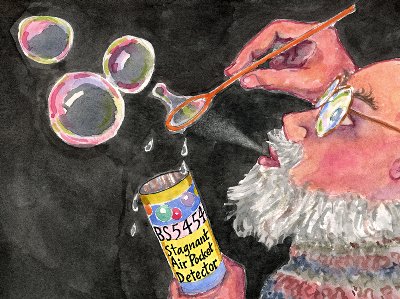
 |
The environmental specifications in BS5454-2000 |
The British Standard for archives BS5454-2000 Recommendations for the storage and exhibition of archival documents is so strict that, if used as a specification, it forces air conditioning, with consequent expense in fuel and maintenance. My argument, in academic detail, is set out in the article Simple climate control in archives
There are really three issues which impede low energy design of archives:
1. The standard is used as a specification
2. The standard imposes a constant temperature in an archive, irrespective of seasonal change outside.
3. The standard emphasises, in several passages, the importance of providing air movement.
1. Standard as specification
On page ii of the standard: This British Standard takes the form of guidance and recommendations. It should not be quoted as if it were a specification...
But in reality it is used as a specification in the architect's brief. Furthermore, compliance is required by authorities which licence the storage of official documents. From The National Archives [UK] Standard for Record Repositories, First edition, 2004: 5.1.1 In respect of storage accommodation they must conform broadly with the current edition of British Standard 5454...
2. Constant temperature
The standard is both specific and ambiguous about temperature:
7.3.1. In order to avoid the need for acclimatization when documents move from storage to reading room and back, the temperature should be at a fixed point between 16°C and 19°C with a tolerance of 1°C on either side, but ranging neither below the minimum nor above the maximum.
This ambiguous formulation seems to mean that there is just one degree of latitude around a set point between 17 and 18. This is the interpretation given in the [UK] National Preservation Office, Basic preservation guidelines for library and archive collections, 2003. Alternatively, the maximum can be read as the top temperature plus the 1 degree latitude. Whatever interpretation one uses, there is hardly a building that can achieve the recommendation, even with air conditioning. (Readers are welcome to provide documentation that they have achieved this degree of perfection for a full year)
However, the most important limitation is that there is no allowance for seasonal drift influenced by the yearly temperature cycle outside. This excludes passive climate control.
3. Ventilation
The standard is illogical here, since if ventilation is truly necessary, each document should be pinned out on a clothes line. The standard hides the purpose: to ensure a uniform temperature, behind a method for achieving this: swirling air around to distribute heat.
There are other ways of ensuring a uniform temperature: rounded corners and lateral heat conduction in the wall, among many design details which would make superfluous the use of air to move heat around. In any case, if the recommended strict temperature is achieved, there is no need to add air movement as a good thing in itself, yet this is repeatedly urged or implied:
7.1 low temperatures with adequate air movement are preferable
7.2 ...an appropriate level of ventilation and air movement within the confines of the space
7.4.1 The air within the repository should not be stagnant. There should be sufficient air movement to avoid pockets of stagnant air.

7.4.2 Shelving: ... There should also be a distance of at least 50 mm between the top of the highest document on each shelf and the bottom of the shelf above.
7.5.1. When the thermal properties of the building and its natural ventilation are insufficient to maintain the stable environment recommended in this standard, ... air conditioning ... may be installed to provide and maintain temperature and relative humidity within the recommended range. Given the plus/minus one degree temperature range, how could one possibly construct a thermal envelope to achieve it without air conditioning?
However, there is conflicting advice advocating very slow air movement, in cupboards (9.8) and in showcases (13.3.2).
The standard gives no quantitative recommendation for ventilation, using meaningless adjectives, in the context of an otherwise very precise standard, like 'adequate ventilation'.
The fact that almost every advisory publication asserts that ventilation inhibits mould growth doesn't make it true. If any reader can point to original experimental research on the matter, please give the reference here.
I'm sorry that the reader has to take my word for much of the standard text. The standard is copyright of the British Standards Institution. I have asked for permission to reproduce the section on climate control. No response yet.
How should we proceed with modernisation of the standard?
The last page of the standard invites participation:
We would be grateful if anyone finding an inaccuracy or ambiguity while using this British Standard would inform the Secretary of the technical committee responsible...
The BSI comments system separates comments so no one knows what others are writing: you have to download a MSWord template to make an individual comment. There seems no way for commenters to see each others suggestions. At present, BS5454 is not open to comment in an invited consultation phase. The debate should be more open, so all can see each others comments. A good system for developing a revised standard is the wiki, which can be edited by anyone (maybe with moderator filtering) so that it develops by collaboration, or dissension, with everyone able to see and react to others' ideas.
tim padfield 2008-05-26 to 2008-09-27

This work is licensed under a Creative Commons Attribution-Noncommercial-No Derivative Works 3.0 License.